Photograph by Ing-On Vibulbhan-Watts
I went to Thailand to visit my family for two months, from July and August 2017. I did not visit home since 2006. I was glad to see my family. I enjoyed seeing all new development in Bangkok and loved eating authentic Thai food, especially Thai fruits.
I had a chance to visit my home town, Lopburi, where I was raised when I was young, before we moved to Bangkok. I traveled to Ayutthaya to see the ruins of temples that were burned by Burmese soldiers, when the Burmese wanted to take over Thailand, The Burmese–Siamese War (1765–1767). Ayutthaya was one of the former capitals of Thailand before moved to, Thonburi and then Bangkok. I also traveled to, Chiang Mai, located in the Northern part of Thailand. Chiang Mai is the second largest and second most popular city of Thailand.
John, my husband came to Thailand in August. He joined me traveling to different part of Thailand. I had a good time taking videos and photographs wherever I traveled around Bangkok and other part of Thailand. I hope the viewers of my website will enjoy the photographs that I present in these projects.
Ing-On Vibulbhan-Watts, Thursday, October 26, 2017
Thai Flag and Wat Phra Kaew in Bangkok, Thailand
Thailand (/?ta?lænd/ TY-land), officially the Kingdom of Thailand and formerly known as Siam, is a country at the center of the Indochinese peninsula in Southeast Asia. With a total area of approximately 513,000 km2 (198,000 sq mi), Thailand is the world’s 50th-largest country. It is the 20th-most-populous country in the world, with around 66 million people.
Thailand is a constitutional monarchy and has switched between parliamentary democracy and military junta for decades, the latest coup being in May 2014 by the National Council for Peace and Order. Its capital and most populous city is Bangkok. It is bordered to the north by Myanmar and Laos, to the east by Laos and Cambodia, to the south by the Gulf of Thailand and Malaysia, and to the west by the Andaman Sea and the southern extremity of Myanmar. Its maritime boundaries include Vietnam in the Gulf of Thailand to the southeast, and Indonesia and India on the Andaman Sea to the southwest.
The Thai economy is the world’s 20th largest by GDP at PPP and the 27th largest by nominal GDP. It became a newly industrialized country and a major exporter in the 1990s. Manufacturing, agriculture, and tourism are leading sectors of the economy. [13][14] It is considered a middle power in the region and around the world.[15]
For more information please visit the following link: https://en.wikipedia.org/wiki/Thailand
History of Thailand
There is evidence of human habitation in Thailand that has been dated at 40,000 years before the present, with stone artifacts dated to this period at Tham Lod Rockshelter in Mae Hong Son. Similar to other regions in Southeast Asia, Thailand was heavily influenced by the culture and religions of India, starting with the Kingdom of Funan around the 1st century CE to the Khmer Empire.[21] Thailand in its earliest days was under the rule of the Khmer Empire, which had strong Hindu roots, and the influence among Thais remains even today.
Indian influence on Thai culture was partly the result of direct contact with Indian settlers, but mainly it was brought about indirectly via the Indianized kingdoms of Dvaravati, Srivijaya, and Cambodia.[22] E.A. Voretzsch believes that Buddhism must have been flowing into Siam from India in the time of the Indian Emperor Ashoka of the Maurya Empire and far on into the first millennium after Christ.[22] Later Thailand was influenced by the south Indian Pallava dynasty and north Indian Gupta Empire.[22]
According to George Cœdès, “The Thai first enter history of Farther India in the eleventh century with the mention of Syam slaves or prisoners of war in” Champa epigraphy, and “in the twelfth century, the bas-reliefs of Angkor Wat” where “a group of warriors” are described as Syam. Additionally, “the Mongols, after the seizure of Ta-li on January 7, 1253 and the pacification of Yunnan in 1257, did not look with disfavor on the creation of a series of Thai principalities at the expense of the old Indianized kingdoms.” The Menam Basin was originally populated by the Mons, and the location of Dvaravati in the 7th century, followed by the Khmer Empire in the 11th. The History of the Yuan mentions an embassy from the kingdom of Sukhothai in 1282. In 1287, three Thai chiefs, Mangrai, Ngam Muang, and Ram Khamhaeng formed a “strong pact of friendship”.[23]
After the fall of the Khmer Empire in the 13th century, various states thrived there, established by the various Tai peoples, Mons, Khmers, Chams and Ethnic Malays, as seen through the numerous archaeological sites and artefacts that are scattered throughout the Siamese landscape. Prior to the 12th century however, the first Thai or Siamese state is traditionally considered to be the Buddhist Sukhothai Kingdom, which was founded in 1238.
Following the decline and fall of the Khmer empire in the 13th–15th century, the Buddhist Tai kingdoms of Sukhothai, Lanna, and Lan Xang (now Laos) were on the rise. However, a century later, the power of Sukhothai was overshadowed by the new Kingdom of Ayutthaya, established in the mid-14th century in the lower Chao Phraya River or Menam area.
Ayutthaya’s expansion centred along the Menam while in the northern valleys the Lanna Kingdom and other small Tai city-states ruled the area. In 1431, the Khmer abandoned Angkor after Ayutthaya forces invaded the city.[24] Thailand retained a tradition of trade with its neighbouring states, from China to India, Persia, and Arab lands. Ayutthaya became one of the most vibrant trading centres in Asia. European traders arrived in the early 16th century, beginning with the envoy of Portuguese duke Afonso de Albuquerque in 1511, followed by the French, Dutch, and English. The Burmese–Siamese War (1765–1767) left Ayutthaya burned and sacked by King Hsinbyushin Konbaung.
After the fall of Ayutthaya in 1767 to the Burmese, Taksin moved the capital to Thonburi for approximately 15 years. The current Rattanakosin era of Thai history began in 1782 following the establishment of Bangkok as capital of the Chakri dynasty under King Rama I the Great. According to the Encyclopædia Britannica, “A quarter to a third of the population of some areas of Thailand and Burma were slaves in the 17th through the 19th centuries.”[25][26]
For more information please visit the following link: https://en.wikipedia.org/wiki/Thailand
Thailand Wat Phra Kaew in Bangkok, Thailand
In 1767, the Kingdom of Ayutthaya fell to the Burmese, and King Taksin then moved the capital to Thonburi where he built the old palace beside Wat Arun on the west bank of Chao Phraya River. In 1778, Taksin’s army under the command of Chao Phraya Chakri (who later became Rama I) captured Vientiane and took the Emerald Buddha back to Thonburi.
In 1782, King Rama I succeeded to the throne and founded the Chakri Dynasty, and he decided to move the capital across the river to Bangkok as it would be better protected from attack.[6] The site chosen for the palace is situated between two old wats, Wat Pho and Wat Mahathat, an area inhabited by Chinese residents who were then moved to the present Chinatown.[7] He started the construction of the Grand Palace so that the palace may be ready for his coronation in 1785. Wat Phra Kaew, which has its own compound within the precinct of the palace, was built to house the Emerald Buddha, which is considered a sacred object that provides protection for the kingdom. Wat Phra Kaew was completed in 1784. [2][8] The formal name of Wat Phra Kaeo is Phra Sri Rattana Satsadaram, which means “the residence of the Holy Jewel Buddha.”
For more information please visit the following link: https://en.wikipedia.org/wiki/Wat_Phra_Kaew
Wat Phra Kaew in Bangkok, Thailand
Wat Phra Kaew[1] is regarded as the most sacred Buddhist temple (wat) in Thailand. The Emerald Buddha housed in the temple is a potent religio-political symbol and the palladium (protective image) of Thai society. [2][3] It is located in Phra Nakhon District, the historic centre of Bangkok, within the precincts of the Grand Palace. [4][5]
The main building is the central phra ubosot, which houses the statue of the Emerald Buddha. According to legend, this Buddha image originated in India where the sage Nagasena prophesized that the Emerald Buddha would bring “prosperity and pre-eminence to each country in which it resides”, the Emerald Buddha deified in the Wat Phra Kaew is therefore deeply revered and venerated in Thailand as the protector of the country. Historical records however dates its finding to Chiang Rai in the 15th century where, after it was relocated a number of times, it was finally taken to Thailand in the 18th century. It was enshrined in Bangkok at the Wat Phra Kaew temple in 1782 during the reign of Phutthayotfa Chulalok, King Rama I (1782–1809). This marked the beginning of the Chakri Dynasty of Thailand, whose current sovereign is Vajiralongkorn, King Rama X.
The Emerald Buddha, a dark green statue, is in a standing form, about 66 centimetres (26 in) tall, carved from a single jade stone (“emerald” in Thai means deep green colour and not the specific stone). It is carved in the meditating posture in the style of the Lanna school of the northern Thailand. Except for the Thai King and, in his stead, the Crown Prince, no other persons are allowed to touch the statue. The King changes the cloak around the statue three times a year, corresponding to the summer, winter, and rainy seasons, an important ritual performed to usher good fortune to the country during each season. [3][4][5]
For more information please visit the following link: https://en.wikipedia.org/wiki/Wat_Phra_Kaew
Wat Phra Kaew in Bangkok, Thailand
Wat Phra Kaew has a plethora of buildings within the precincts of the Grand Palace, which covers a total area of over 94.5 hectares (234 acres). It has over 100 buildings with “200 years royal history and architectural experimentation” linked to it. The architectural style is named as Rattanakosin style (old Bangkok style). The main temple of the Emerald Buddha is very elegantly decorated and similar to the temple in ancient capital of Ayudhya. The roof is embellished with polished orange and green tiles, the pillars are inlaid in mosaic and the pediments are made of rich marble, installed around 18th century. The Emerald Buddha is deified over an elevated altar surrounded by large gilded decorations. While the upper part of this altar was part of the original construction, the base was added by King Rama III. Two images of the Buddha, which represent the first two kings of the Chakri dynasty, flank the main image. Over the years, the temple has retained its original design. However, minor improvements have been effected after its first erection during Rama I’s reign; wood-work of the temple was replaced by King Rama III and King Chulalongkorn; during King Mongkut’s reign, the elegant doors and windows and the copper plates on the floor were additions, Rama III refurbished the wall painting (indicative of the universe according to Buddhist cosmology) and several frescoes that display the various stages of the Buddha’s life; three chambers were added on the western side by King Mongkut; in the chamber known as ‘Phra Kromanusorn’ at the northern end, images of Buddha have been installed in honour of the kings of Ayutthaya; and in the 19th century, Khrua In Khong, a famous painter executed the wall murals. The entry to the temple is from the third gate from the river pier. [3][5][10][11][12][13][14]
For more information please visit the following link: https://en.wikipedia.org/wiki/Wat_Phra_Kaew
Thai Wall Murals of Wat Phra Kaew
Wat Phra Kaew in Bangkok, Thailand
Excerpts from the Ramakien Part 1
Demon king Totsakan seduces his niece in the mistaken belief that she is Princess Sita.
With the help of Sukreep, Hanuman and the other monkey warriors, Prince Rama’s army defeats the army of the demon king Totsakan, and advances towards his palace. In desperation, Totsakan devises a ploy to defuse the cause of the war. If Princess Sita were dead, he thinks, Prince Rama would discontinue the war. He therefore orders his niece, Princess Benjakai, to transform herself into Princess Sita, feign dead and float pass Prince Rama’s camp on the river.
Ramakien is a well-known epic in Thailand, derived from the Indian epic Ramayana. The main story is identical to that of the Ramayana. The major part of the Ramakien revolves around the war between Rama, the rightful king of Ayutthaya, and Totsakan, the evil king of the island of Lanka, who had abducted Rama’s beautiful wife, Sita, and taken her to Lanka. Rama is assisted by several monkey warriors. Totsakan’s allies are various demons.
This is the Thai version of the Indian Ramayana, an allegory of the triumph of good versus evil. Our hero, Rama is a paragon of virtue – the ideal king. The villain, or demon king Tosakan. This epic tale is thought to established after the Thais occupied Angkor in the 15th century. It has been an inspiration for painting and classical drama.
For more information please visit the following links: https://en.wikipedia.org/wiki/Wat_Phra_Kaew
https://www.mytripblog.org/pg/blog/thailand-social-manager/read/31814/the-story-of-ramakien
https://www.thaiembassy.no/News/joe_louis/en_Ramakien.html
Thai Wall Murals of Wat Phra Kaew
Wat Phra Kaew in Bangkok, Thailand
Excerpts from the Ramakien Part 2
Princess Benjakai listens to his order and later re-appears before him as the beautiful Princess Sita. Totsakan is so taken by the tr ansformation that he mistakes her for the real Princess Sita with whom he is madly in love and begins to seduce her with unrelenting ardour. Princess Benjakai tries to convince him that she is his niece, not Princess Sita. Eventually she succeeds, and carries out his order to feign dead and float in the river to Prince Rama’s camp.
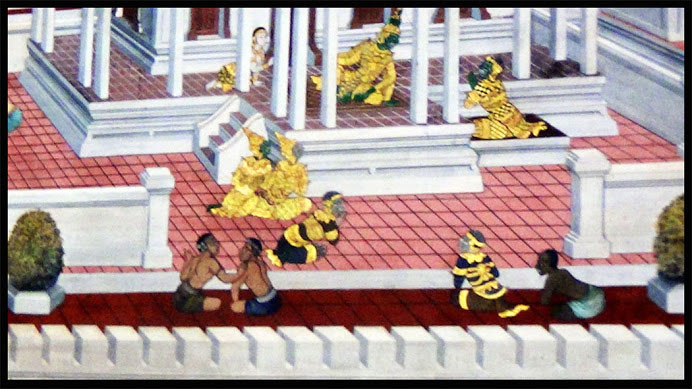 Thai Wall Murals of Wat Phra Kaew
Thai Wall Murals of Wat Phra Kaew
Welcome To My Beloved Country, Thailand
Wat Phra Kaew in Bangkok, Thailand
Photograph by Ing-On Vibulbhan-Watts
Excerpts from the Ramakien Part 3
The white monkey warrior Hanuman captures Princess Benjakai.
The body of Princess Benjakai, appearing as that of Princess Sita, arrives on the bank of the river
by Prince Rama’s camp. Hanuman sees it but suspects trickery as the body had unnaturally floated against the current. He suspects the body not to be of Princess Sita but of Princess Benjakai, demon king Totsakan’s niece. Knowing that Princess Sita is impervious to fire and Princess Benjakai is not, he puts the body to the ultimate test.
 Thai Wall Murals of Wat Phra Kaew
Thai Wall Murals of Wat Phra Kaew
Welcome To My Beloved Country, Thailand
Wat Phra Kaew in Bangkok, Thailand
Photograph by Ing-On Vibulbhan-Watts
Excerpts from the Ramakien Part 4
On contact with fire, the body of Princess Benjakai escapes quickly into the skies. Hanuman tries to stop her, but she escapes into the clouds. Being Hanuman – or rather, animal – his glimpse of her had left a dent in his heart and so the great white monkey warrior pursues her assiduously through the skies and succeeds in bringing her back to camp. She is later seduced by him and becomes his wife.
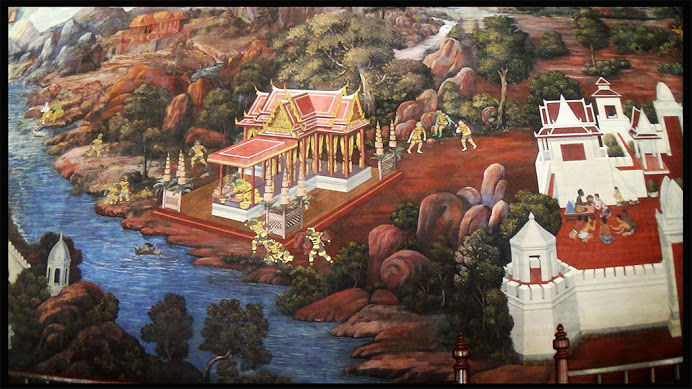
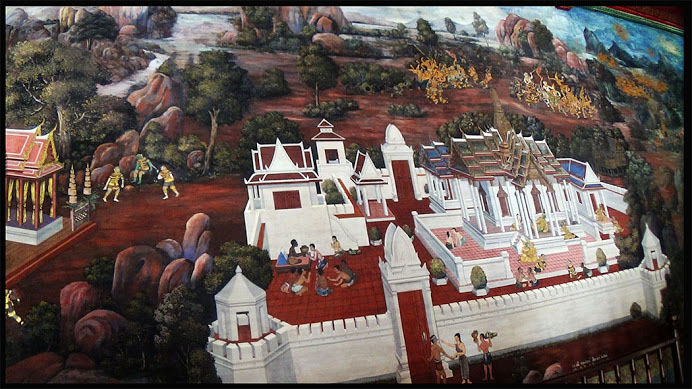
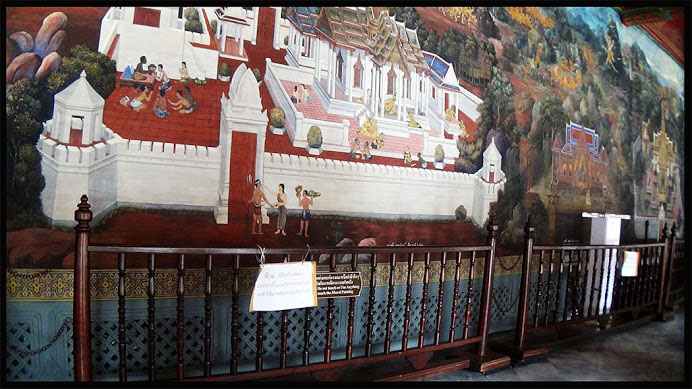
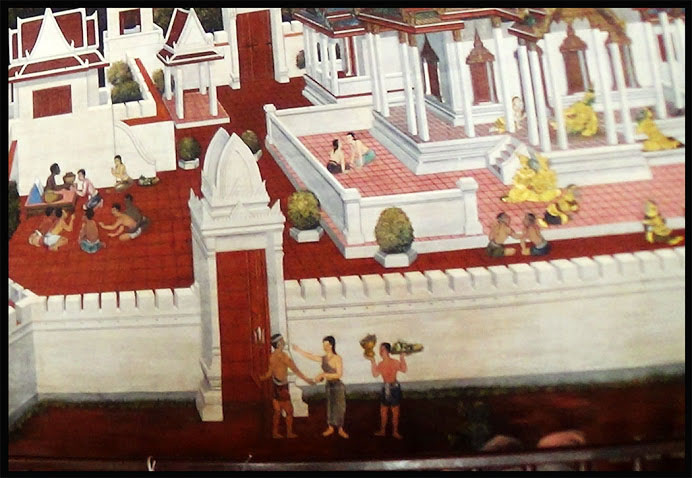
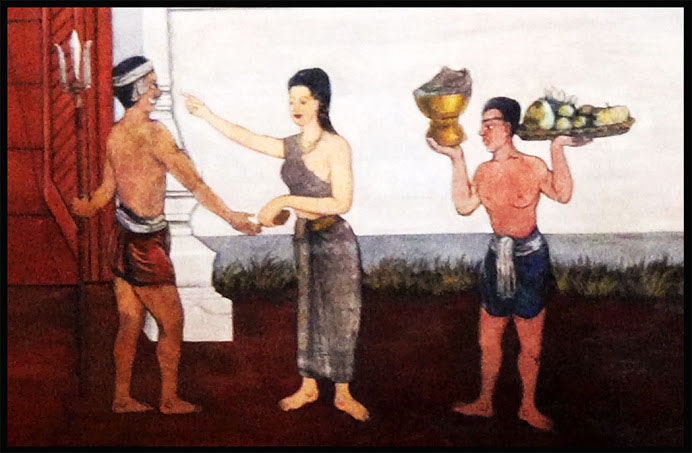 Wat Phra Kaew in Bangkok, Thailand
Wat Phra Kaew in Bangkok, Thailand
Photograph by Ing-On Vibulbhan-Watts
The entire complex, including the temples, is bounded by a compound wall which is one of the most prominent part of the wat is about 2 kilometres (6,600 ft) length. The compound walls are decorated with typically Thai murals, based on the Indian epic Ramayana. In Thai language these murals are known to form the Ramakian, the Thai national epic, which was written during the reign of Rama I. The epic stories formed the basic information to draw the paintings during the reign of King Rama I (1782–1809). These paintings are refurbished regularly. The murals, in 178 scenes, starting with the north gate of the temple illustrates the complete epic story of Ramayana sequentially, in a clockwise direction covering the entire compound wall. The murals serve to emphasize human values of honesty, faith, and devotion. [3][5][10][13]
For more information please visit the following link: https://en.wikipedia.org/wiki/Wat_Phra_Kaew


 Thai Wall Murals of Wat Phra Kaew
Thai Wall Murals of Wat Phra Kaew
Welcome To My Beloved Country, Thailand
Wat Phra Kaew in Bangkok, Thailand
Photograph by Ing-On Vibulbhan-Watts
The entire complex, including the temples, is bounded by a compound wall which is one of the most prominent part of the wat is about 2 kilometres (6,600 ft) length. The compound walls are decorated with typically Thai murals, based on the Indian epic Ramayana. In Thai language these murals are known to form the Ramakian, the Thai national epic, which was written during the reign of Rama I. The epic stories formed the basic information to draw the paintings during the reign of King Rama I (1782–1809). These paintings are refurbished regularly. The murals, in 178 scenes, starting with the north gate of the temple illustrates the complete epic story of Ramayana sequentially, in a clockwise direction covering the entire compound wall. The murals serve to emphasise human values of honesty, faith, and devotion.[3][5][10][13]
For more information please visit the following links: https://en.wikipedia.org/wiki/Wat_Phra_Kaew
https://www.thaiembassy.no/News/joe_louis/en_Ramakien.html
https://www.mytripblog.org/pg/blog/thailand-social-manager/read/31814/the-story-of-ramakien
 Wat Phra Kaew in Bangkok, Thailand
Wat Phra Kaew in Bangkok, Thailand
There are twelve salas that were built by Rama I, around the temple. They house interesting artefacts of regions such as Cambodia and Java. One of these salas had an inscription of Ramkamhaeng, which was shifted, in 1924, to the National Library. During the reign of King Mongkut, the Phra Gandharara – small chapel on the southwest corner – and a tall belfry were new additions.[3]
For more information please visit the following link: https://en.wikipedia.org/wiki/Wat_Phra_Kaew
 Golden Chedi of Wat Phra Kaew
Golden Chedi of Wat Phra Kaew
Wat Phra Kaew in Bangkok, Thailand
In 1767, the Kingdom of Ayutthaya fell to the Burmese, and King Taksin then moved the capital to Thonburi where he built the old palace beside Wat Arun on the west bank of Chao Phraya River. In 1778, Taksin’s army under the command of Chao Phraya Chakri (who later became Rama I) captured Vientiane and took the Emerald Buddha back to Thonburi.
In 1782, King Rama I succeeded to the throne and founded the Chakri Dynasty, and he decided to move the capital across the river to Bangkok as it would be better protected from attack.[6] The site chosen for the palace is situated between two old wats, Wat Pho and Wat Mahathat, an area inhabited by Chinese residents who were then moved to the present Chinatown.[7] He started the construction of the Grand Palace so that the palace may be ready for his coronation in 1785. Wat Phra Kaew, which has its own compound within the precinct of the palace, was built to house the Emerald Buddha, which is considered a sacred object that provides protection for the kingdom. Wat Phra Kaew was completed in 1784.[2][8] The formal name of Wat Phra Kaeo is Phra Sri Rattana Satsadaram, which means “the residence of the Holy Jewel Buddha.”
For more information please visit the following link: https://en.wikipedia.org/wiki/Wat_Phra_Kaew
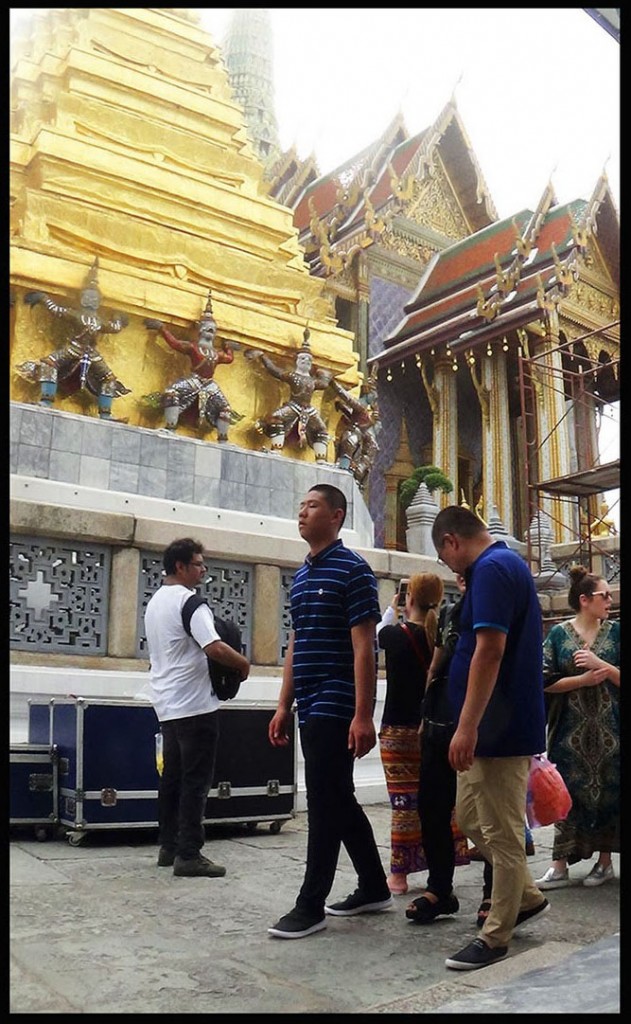 Golden Chedi of Wat Phra Kaew
Golden Chedi of Wat Phra Kaew
Wat Phra Kaew has undergone a number of renovations, restoration and additions in its history, particularly during the reign of King Rama III and Rama IV. Rama III started the renovations and rebuilding in 1831 for the 50th Anniversary of BangkoK of 1832, while Rama IV’s restoration was completed by Rama V in time for the Bangkok Centennial celebrations in 1882. Further restoration was undertaken by Rama VII on Bangkok’s 150th Anniversary in 1932, and by Rama IX for the 200th Anniversary in 1982. [2]
For more information please visit the following link: https://en.wikipedia.org/wiki/Wat_Phra_Kaew

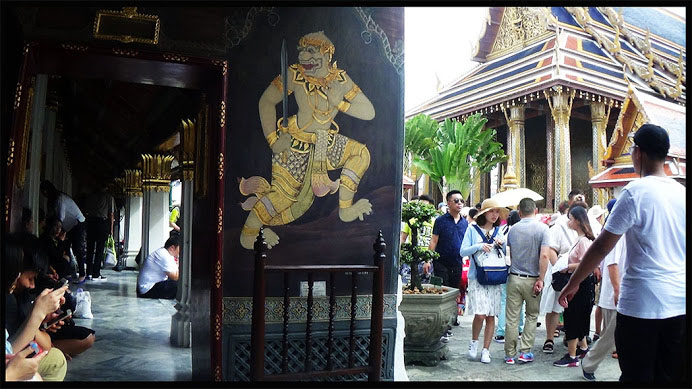 Thai Murals of Wat Phra Kaew
Thai Murals of Wat Phra Kaew
Wat Phra Kaew in Bangkok, Thailand
A painted representation of the Ramakien is displayed at Bangkok’s Wat Phra Kaew, and many of the statues there depict characters from it.
For more information please visit the following link: https://en.wikipedia.org/wiki/Wat_Phra_Kaew
Wat Phra Kaew[1] is regarded as the most sacred Buddhist temple (wat) in Thailand. The Emerald Buddha housed in the temple is a potent religio-political symbol and the palladium (protective image) of Thai society. [2][3] It is located in Phra Nakhon District, the historic centre of Bangkok, within the precincts of the Grand Palace. [4][5]
The main building is the central phra ubosot, which houses the statue of the Emerald Buddha. According to legend, this Buddha image originated in India where the sage Nagasena prophesized that the Emerald Buddha would bring “prosperity and pre-eminence to each country in which it resides”, the Emerald Buddha deified in the Wat Phra Kaew is therefore deeply revered and venerated in Thailand as the protector of the country. Historical records however dates its finding to Chiang Rai in the 15th century where, after it was relocated a number of times, it was finally taken to Thailand in the 18th century. It was enshrined in Bangkok at the Wat Phra Kaew temple in 1782 during the reign of Phutthayotfa Chulalok, King Rama I (1782–1809). This marked the beginning of the Chakri Dynasty of Thailand, whose current sovereign is Vajiralongkorn, King Rama X.
The Emerald Buddha, a dark green statue, is in a standing form, about 66 centimetres (26 in) tall, carved from a single jade stone (“emerald” in Thai means deep green colour and not the specific stone). It is carved in the meditating posture in the style of the Lanna school of the northern Thailand. Except for the Thai King and, in his stead, the Crown Prince, no other persons are allowed to touch the statue. The King changes the cloak around the statue three times a year, corresponding to the summer, winter, and rainy seasons, an important ritual performed to usher good fortune to the country during each season. [3][4][5]
For more information please visit the following link: https://en.wikipedia.org/wiki/Wat_Phra_Kaew
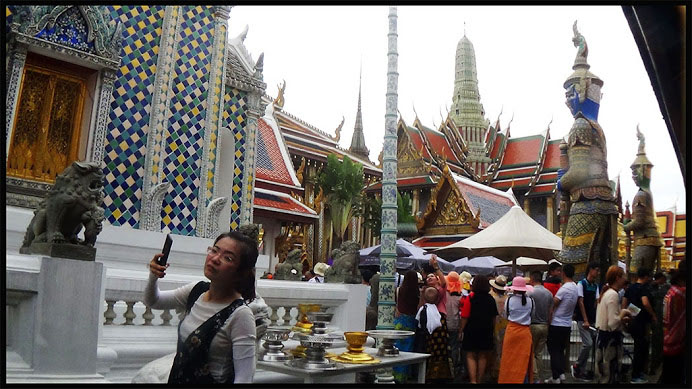 Wat Phra Kaew in Bangkok, Thailand
Wat Phra Kaew in Bangkok, Thailand
The entrance is guarded by a pair of yakshis (mythical giants – 5 metres (16 ft) high statues). The eponymous image Buddha in brilliant green colour is 66 centimetres (26 in) in height with a lap width of 48.3 centimetres (19.0 in). It is carved in a yogic position, known as Virasana (a meditation pose commonly seen in images in Thailand and also in South India, Sri Lanka and Southeast Asia). The pedestal on which the Emerald Buddha deified is decorated with Garuda (the mythical half-man half-bird form, a steed of Rama, who holds his mortal enemy Naga the serpent in his legs) motifs It is central to Thai Buddhism. The image made with a circular base has a smooth top-knot that is finished with a “dulled point marking at the top of the image”. A third eye made in gold is inset over the elevated eyebrows of the image. The image appears divine and composed, with the eyes cast downward. The image has a small nose and mouth (mouth closed) and elongated ears. The hands are seen on the lap with palms facing upwards. [3][12][15]
For more information please visit the following link: https://en.wikipedia.org/wiki/Wat_Phra_Kaew
A group of Thai Buddhist Monks at the Wat Phra Kaew temple
A ceremony that is observed in the wat is the Chakri Day (begun on April 6, 1782), a national holiday to honour founding of the Chakri dynasty. On this day, the king attends the ceremony. The former king Rama IX, with his Queen, and entourage of the royal family, the Prime Minister, officials in the Ministry of Defence, and other government departments, first offered prayers at the Emerald Buddha temple. This was followed by visit to the pantheon to pay homage to the images of past Chakri rulers that are installed there. [3]
For more information please visit the following link: https://en.wikipedia.org/wiki/Wat_Phra_Kaew
Thai Murals of Wat Phra Kaew
Ramakien is a well-known epic in Thailand, derived from the Indian epic Ramayana. The main story is identical to that of the Ramayana. The major part of the Ramakien revolves around the war between Rama, the rightful king of Ayutthaya, and Totsakan, the evil king of the island of Lanka, who had abducted Rama’s beautiful wife, Sita, and taken her to Lanka. Rama is assisted by several monkey warriors. Totsakan’s allies are various demons.
This is the Thai version of the Indian Ramayana, an allegory of the triumph of good versus evil. Our hero, Rama is a paragon of virtue – the ideal king. The villain, or demon king Tosakan. This epic tale is thought to established after the Thais occupied Angkor in the 15th century. It has been an inspiration for painting and classical drama.
For more information please visit the following links: https://en.wikipedia.org/wiki/Wat_Phra_Kaew
https://www.thaiembassy.no/News/joe_louis/en_Ramakien.html
https://www.mytripblog.org/pg/blog/thailand-social-manager/read/31814/the-story-of-ramakien

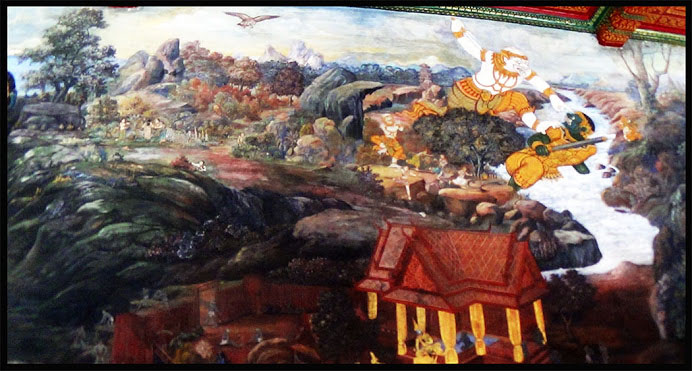
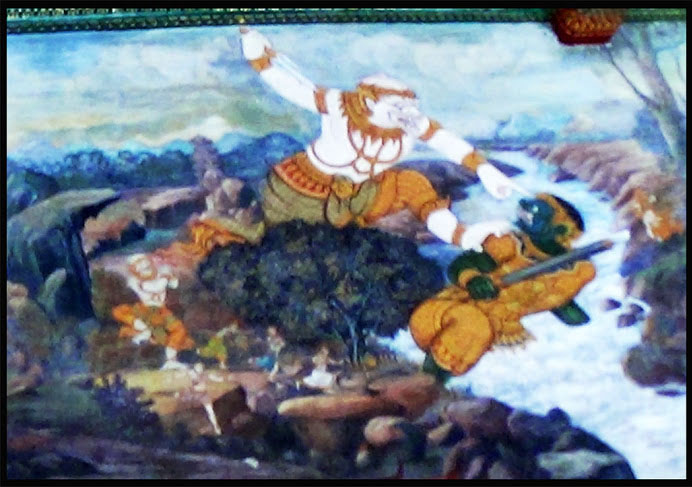 Thai Murals at Wat Phra Kaew in Bangkok, ThailandWelcome To My Beloved Country, Thailand
Thai Murals at Wat Phra Kaew in Bangkok, ThailandWelcome To My Beloved Country, Thailand
Photograph by Ing-On Vibulbhan-Watts
The entire complex, including the temples, is bounded by a compound wall which is one of the most prominent part of the wat is about 2 kilometres (6,600 ft) length. The compound walls are decorated with typically Thai murals, based on the Indian epic Ramayana. In Thai language these murals are known to form the Ramakian, the Thai national epic, which was written during the reign of Rama I. The epic stories formed the basic information to draw the paintings during the reign of King Rama I (1782–1809). These paintings are refurbished regularly. The murals, in 178 scenes, starting with the north gate of the temple illustrates the complete epic story of Ramayana sequentially, in a clockwise direction covering the entire compound wall. The murals serve to emphasise human values of honesty, faith, and devotion. [3][5][10][13]
There are twelve salas that were built by Rama I, around the temple. They house interesting artefacts of regions such as Cambodia and Java. One of these salas had an inscription of Ramkamhaeng, which was shifted, in 1924, to the National Library. During the reign of King Mongkut, the Phra Gandharara – small chapel on the southwest corner – and a tall belfry were new additions. [3]
For more information please visit the following link: https://en.wikipedia.org/wiki/Wat_Phra_Kaew
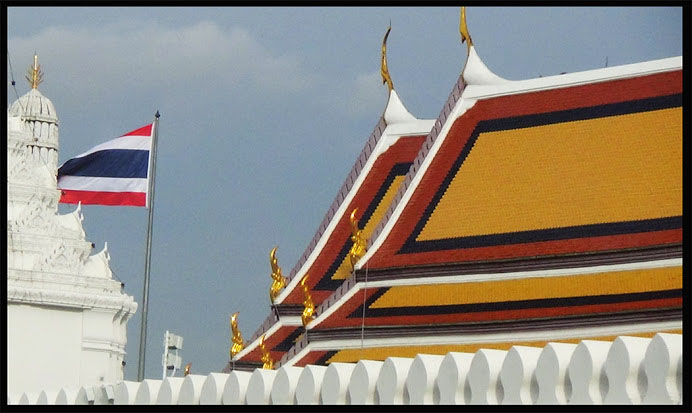
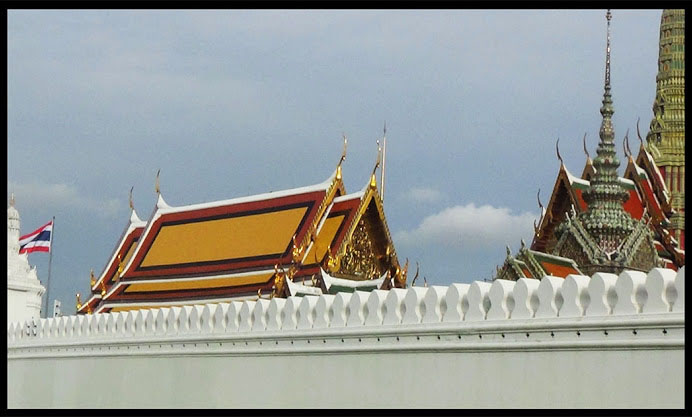
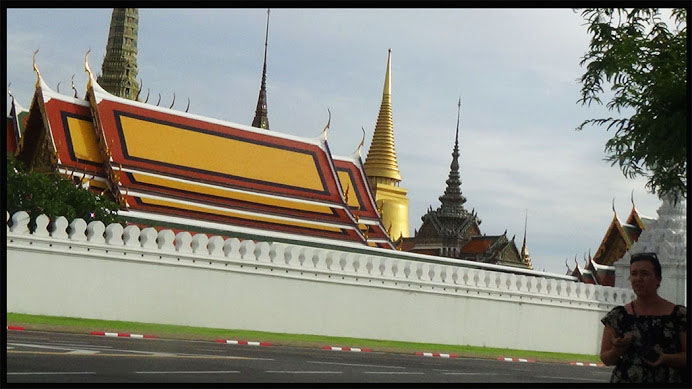
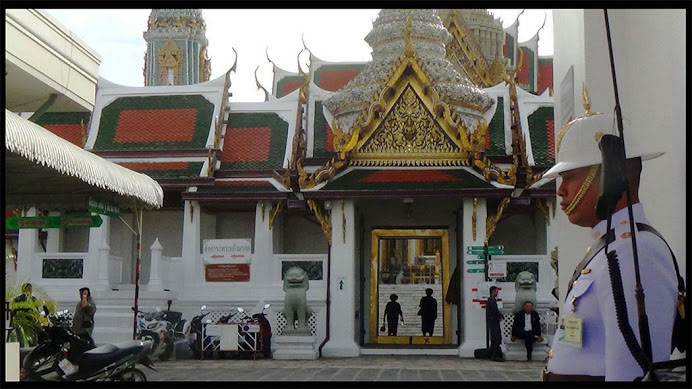
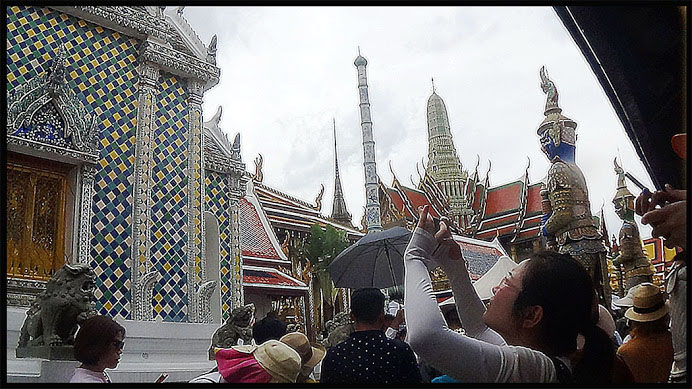
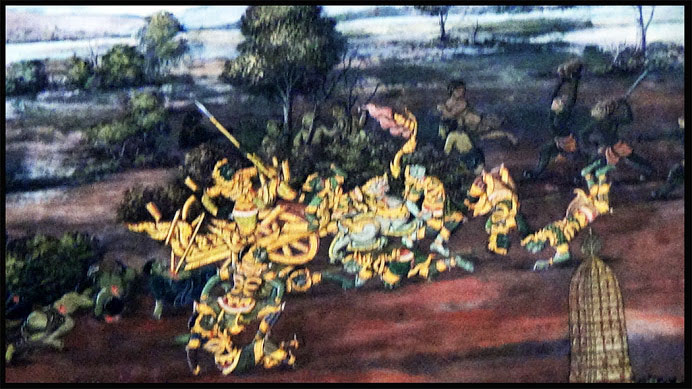
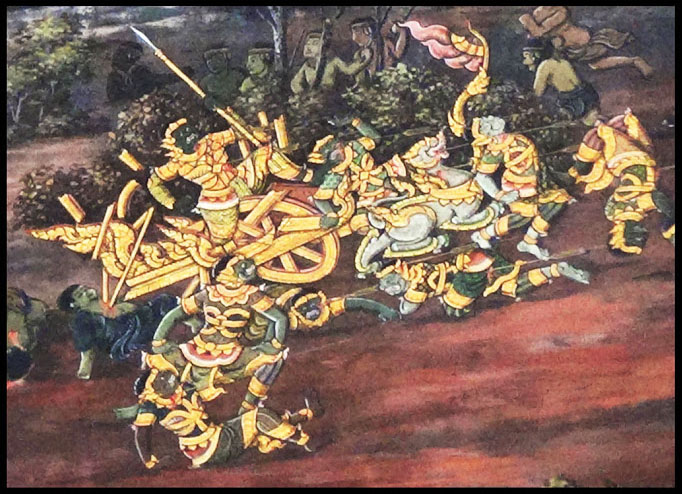

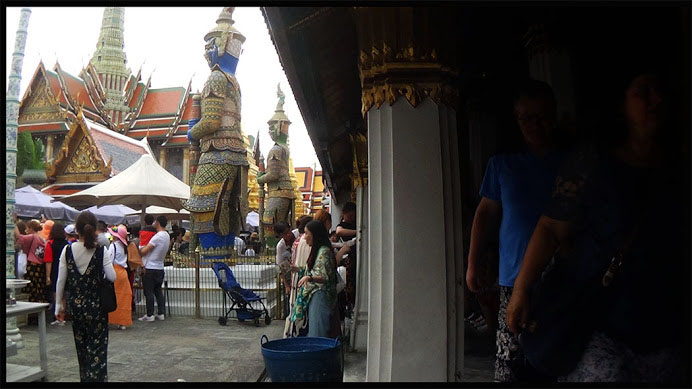
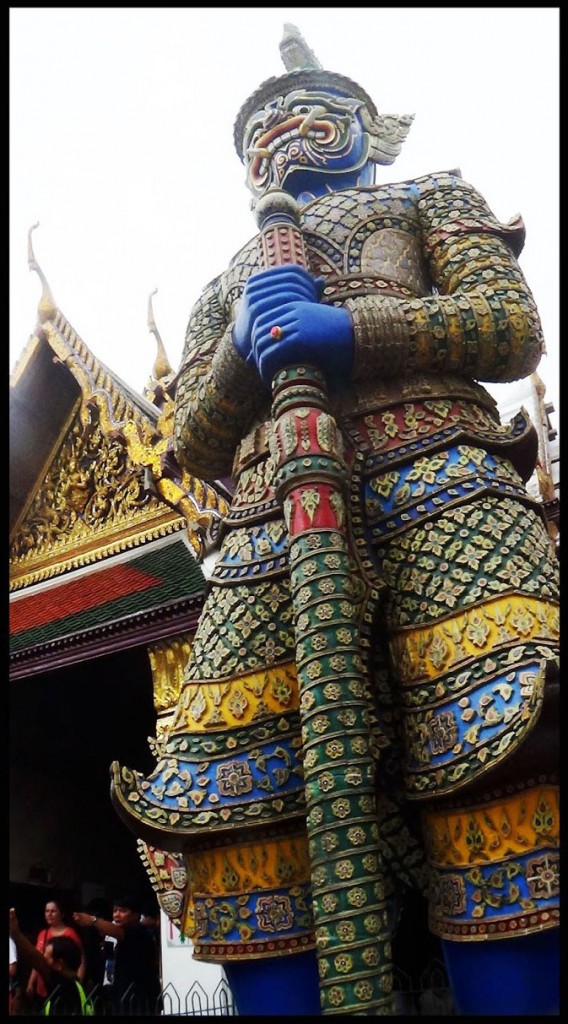
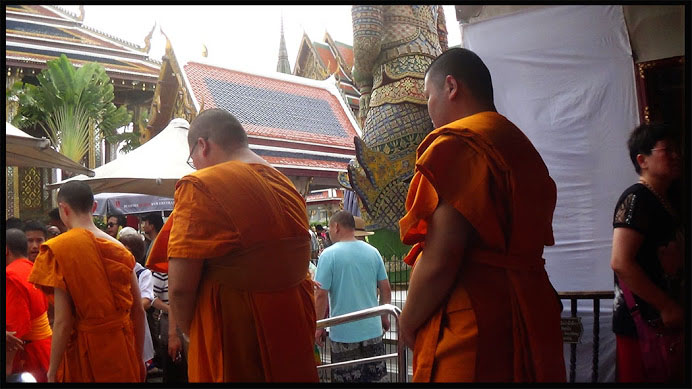
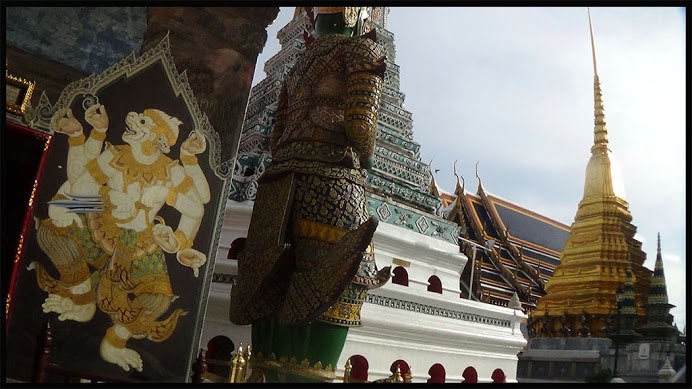

Leave a Reply